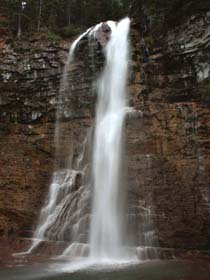Music • Photography • Writing
National Parks Of The American Rockies
Glacier
Page
1
Page
2
Page
3
Page
4
Page
5
Page
6

The west side of Glacier is much different from the east side, which is similar to the Colorado Rockies with which I'm quite familiar. The west side is the easternmost outpost of the Northwest forests, with trees like western redcedar, larch, birch, and alder. So a hike up to Avalanche Lake is in some ways more like a walk in the Olympics or the Cascades than the Rockies. This shot of Avalanche Gorge was taken in the soft light of evening, which allows a slow shutter speed to soften the flowing water. Avalanche Lake, an easy two-mile hike, is a favorite with humans and bears alike. Remember the old adage: You don't have to be faster than the bear, just faster than the other people you're with.
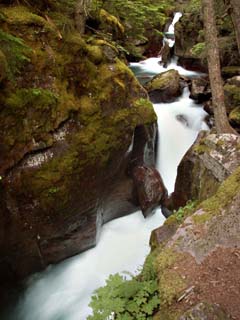
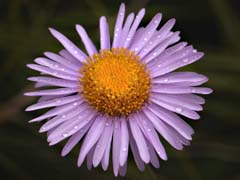
Whenever I'm hiking on a sunny day, passersby always comment on my good fortune, but they don't realize that for some photos, especially flowers, cloudy days can be much better. This fleabane daisy is still dotted with raindrops from an earlier shower.
Glacier became a national park in 1910, but it wasn't until the following decades that many of the trails were built, often by Depression Era labor forces like the WPA. The builders of the trail from Lake Elizabeth to Ptarmigan Lake had a problem at the top of the pass, however: rocky cliffs on both sides. So instead they blasted a tunnel through the solid rock, the only tunnel I know of that was created for a hiking trail. From this, the north side, you can see one of the five peaks over 10,000 feet in the park, as well as Lake Elizabeth and Canada off in the distance. The metal doors are closed in winter to prevent the tunnel filling up with snow.
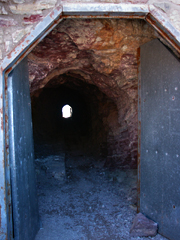
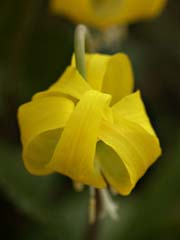
Glacier or avalanche lilies are in the same family as beargrass, but they have very different lifestyles. Glacier lilies grow from a small perennial bulb at the first sign of spring. In fact, the plants have a very strong metabolism and give off enough heat to grow and even bloom in a small opening that they create under the snow, only to appear as if by magic when the snow melts. This picture shows the three-part symmetry of the lily family: six petals, six stamens, and three lobes on the white stigma below. Like most spring bulbs, they bloom and then quickly die back, awaiting the next spring.
Glacier could have been named "Waterfall National Park." The plentiful winter snows and the horizontal layers of the prevailing sedimentary rock are perfect for spectacular waterfalls. The mile and a half trail from Virginia Falls to St. Mary Falls has many other, smaller but still beautiful falls. This shot of St. Mary Falls, on the main tributary to very large St. Mary Lake, was taken in the afternoon, so the fast shutter speed captured the fine detail of the cascading, ice-blue water.
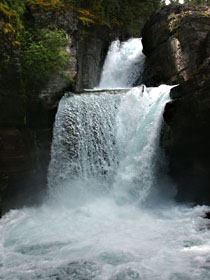
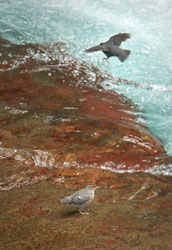
I've seen loons and wood ducks in Glacier, two beautiful bird species. But for fun bird watching, I'll take these little gray chaps anyday. Called ouzels or dippers, they nest behind waterfalls and find their food under that rushing, ice-cold water, where they can flap their wings and fly to swim. They eat mostly larvae, especially those of the caddis fly, which build their own elaborate casings and creep along the stream bed gathering algae and other small organisms. The name "dipper," in addition to their frequent chilly dips, comes from the characteristic dipping motion they make when not in the water, flexing their legs as though saying, "Man, that's cold!" Here, a mother searches for food for her newly fledged chick.
Virginia Falls, about a hundred feet tall, is one of the best hike destinations in the park. An easy, relatively short trail leads the hiker past many falls, with this spectacular waterfall at the end. You can walk right up to the edge of the pool at the base of the falls and feel the chilly rush of misty breeze that the waterfall creates. Another smaller fall just below this makes this one of the really great views in the park. One note of caution: around streams and waterfalls, the noise of the rushing water can make it hard for you and the bears to hear one another. Keep your eyes open so no one is surprised.
